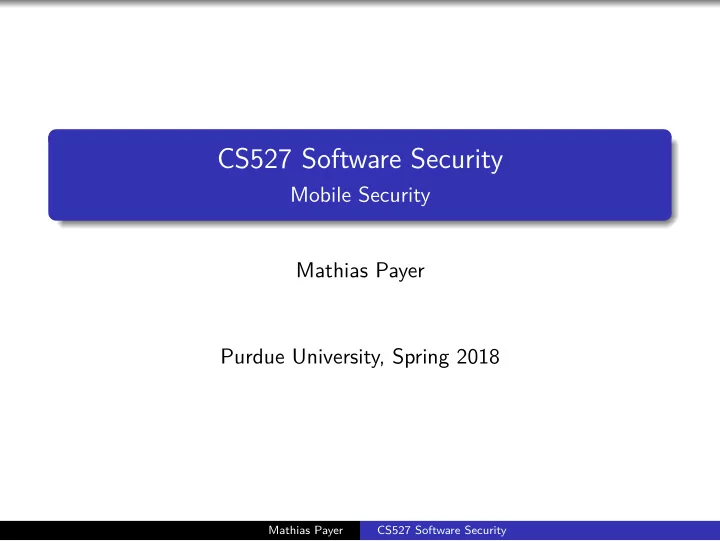

CS527 Software Security Mobile Security Mathias Payer Purdue University, Spring 2018 Mathias Payer CS527 Software Security
Android statistics 1.4 billion users (1) Android generates $31 billion revenue (2) 4,000+ different devices (1) Android OS with highest crash rate: Gingerbread (3) Percentage of Android devices running Marshmallow: 1.2% (1) Percentage of Android devices running Lollipop: 34.1% (1) (1 DMR stats, 9/29/15, 2 Bloomberg, 1/21/16, 3 Greenbot, 3/27/14) Mathias Payer CS527 Software Security
Android history 2005: Google buys Android 2007: Initial SDK released 2008: First devices announced 2009: Cupcake (1.5, 3), Donut (1.6, 4), Eclair (2.0, 5) 2010: Froyo (2.2, 8), Gingerbread (2.3, 9) 2011: Honeycomb (3.0, 11), Ice Cream Sandwich (4.0.1, 14) 2012: Jelly Been (4.1.1, 16) 2013: KitKat (4.4, 19) 2014: Lollipop (5.0, 21) 2015: Marshmallow (6.0, 23) 2016: Nougat (7.0, 24-25) 2017: Oreo (8.0 - 8.1, 26-27) 2018: Android P? Mathias Payer CS527 Software Security
Android security goals Isolate individual applications Protect system resources from applications Vet applications “online” Protect data of the user (until 5.0 single user) Mathias Payer CS527 Software Security
Android security architecture Applications are carefully vetted server-side and only approved applications can be installed from the “market” Each application runs in a Java-like sandbox and is restricted to user-granted permissions and can therefore only communicate through well-defined API channels with other applications The system is hardened against local user (app-based) attacks. Mathias Payer CS527 Software Security
Android app security Each apps runs in its own secure context/sandbox Interactions between apps are restricted through the API Each app has an associated policy, encoding the permissions Apps are signed by the developer, vetted, and installed from a central market Mathias Payer CS527 Software Security
Android system security Hardened Linux kernel protects applications Each application runs as its independent user Stringent permissions on file systems (except sdcard) SELinux to apply access control policies on processes File system encryption User-space: stack canaries, integer overflow mitigation, double free protection (through allocator), fortify source, NX, mmap_min_addr , ASLR, PIE, relro, immediate binding Each release: security updates, patches, toolchain updates, tigther security defaults Mathias Payer CS527 Software Security
Android permissions Complex permission system on a per-app basis. Camera Location Bluetooth Telephony SMS/MMS functionality Network/data connections Mathias Payer CS527 Software Security
Android intents Google’s idea of mobile IPC An Intent is a simple message object that represents an “intention” to do something. For example, if your application wants to display a web page, it expresses its “Intent” to view the URL by creating an Intent instance and handing it off to the system. The system locates some other piece of code (in this case, the Browser) that knows how to handle that Intent, and runs it. Intents can also be used to broadcast interesting events (such as a notification) system-wide. (From Google’s Android website.) Mathias Payer CS527 Software Security
(Some) Android attack vectors Unauthorized intent receipt: attacker creates an intent filter, receives other apps’ intents that contain privileged information (e.g., intent filter for web service intercepts online payment process) Intent spoofing: attacker sends a malicious intent to an intent processor (e.g., flooding the network with malicious messages) Insecure storage: there are no access restrictions on the SD card (why?), an attacker may read/write any data on the SD card Insecure communication: run Wireshark to intercept traffic Overprivileged app: confused deputy, bugs in application can be leveraged by attacker to gain privileges Unsafe privileges: there’s only one Bluetooth privilege, privileges are per app , not per connected device Mathias Payer CS527 Software Security
Summary and conclusion Android security evolved over time Android systems hardened against exploits Developers sign apps which identifies them (comes with a cost) Applications are vetted centrally and installed from the market Mathias Payer CS527 Software Security
Recommend
More recommend